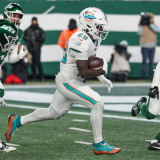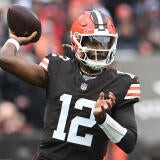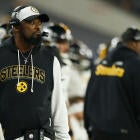
Lions Report Card: Dominant performance beats Jaguars
Detroit produced its most dominant effort of the season, scoring 21 unanswered first-half points en route to a lopsided 31-14 win.
 |
| The Lions are on a roll after dominating the Jaguars on Sunday. Can Matthew Stafford and company keep it up? (US Presswire) |
After the Lions’ thrilling win over the Seahawks in Week 8, Sunday’s trip to EverBank Field to face the struggling Jaguars had all the makings of a classic trap game. Instead, Detroit produced its most dominant effort of the season, scoring 21 unanswered first-half points en route to a lopsided 31-14 win.
The victory gives the Lions back-to-back solid performances to learn from as they prepare for a crucial NFC North battle with the Vikings at the Metrodome this week, and our grades reflect a quality showing with very few mistakes to correct:
Offense: A-
The good: For the second time this season -- Detroit’s loss to Tennessee was the first -- the success of the Lions’ run game gave the passing attack an opportunity to shine. Mikel Leshoure rushed for three touchdowns in the opening half, something not even the great Barry Sanders was able to do during his career, and Leshoure's 4.4 average yards per carry taxed the Jaguars’ linebacking corps by forcing them to respect the run.
Second-year back Joique Bell continues to be a perfect complement to Leshoure. His 109 yards of total offense [73 rushing, 36 receiving] gave the offense a true dual-threat offensive option that hasn’t been present since Jahvid Best’s concussion in Week 6 of the 2011 season.
Matthew Stafford didn’t throw for a touchdown against the Jaguars, but his performance --he went 22 for 33 for 285 yards -- was central to Detroit’s success. Stafford’s play against Jacksonville’s initial two-high safety looks forced a change in their defensive game plan, and he was able to keep multiple receivers involved in the game while still making Calvin Johnson his primary target.
Questions over Johnson’s fitness dominated the build-up to Sunday’s game, and the admittedly hobbled receiver played through pain to take a lead role in Detroit’s one-sided first half. Johnson caught all six balls thrown his way before halftime, gaining 111 yards and nearly scoring his second touchdown of the year.
Johnson was able to exploit favorable coverage matchups because of the steady play of his fellow receivers. Ryan Broyles didn’t drop a pass all game [six catches for 52 yards], and his ability to find space between layers in Jacksonville’s coverage frustrated a Jaguar defensive backfield that was truly stretched sideline-to-sideline by the Lions’ passing attack.
The O-line’s play was nothing short of outstanding. The use of Riley Reiff as an extra lineman in key situations has given the run game an extra dimension, and the unit’s ability to protect Stafford in the pocket was a key element of Detroit’s 66 percent third-down conversion rate.
The Bad: Stafford’s throws weren’t precise on the Lions’ first three drives. He has developed a tendency to deliver the ball high to his receivers in pressure situations, allowing defenses to close to the ball. That inaccuracy didn’t hurt him against a bad Jaguars team, but it could cost Detroit against the better defenses they’ll face in the season’s second half. Previous game’s grade: B+
Defense: B+
The Good: The Lions simply outclassed Jacksonville in the first half. Not only were the Jaguars held without a score before halftime, they managed just three first downs, and didn’t cross the 50-yard line until the second to last play of the half.
The linebacking corps’ best performance of the season helped hold Jacksonville to just 64 rushing yards. Stephen Tulloch and Justin Durant combined for 12 tackles, and Ashlee Palmer added an additional three in place of the injured DeAndre Levy. By eliminating Jacksonville’s rushing lanes, the unit forced the Jaguars to rely on Blaine Gabbert’s inconsistent arm to try and move the ball.
Once the linebacking corps turned the Jaguars into a one-dimensional offense based around an ineffective passer, Detroit’s pass rush was able to control the suspect Jacksonville O-line. The front four only sacked Gabbert once, but that was largely due to his quick delivery designed to avoid D-line pressure. By delivering the ball quickly, Gabbert avoided potential sacks, but he also allowed the Lions’ secondary the opportunity to better read his receivers’ routes.
The secondary took advantage of the front seven’s solid performance by intercepting Gabbert on consecutive third quarter drives. Rookie CB Jonte Green had his best game of the season, leading the defensive backfield with five tackles and one of the two interceptions. Safety Erik Coleman took advantage of his opportunity to start in place of the injured Amari Spievey by controlling the middle of the field, and making his first interception as a Lion.
The bad: When you shut out an opponent in the first half while your offense builds a three-touchdown lead, there’s not much to complain about. Detroit allowed Gabbert to throw for two touchdowns that had little effect on the final score, but those touchdowns came against prevent defenses that the Lions wouldn’t have used if the game were in doubt. Previous game’s grade: B+
Special Teams: B+
The good: Detroit’s coverage teams played flawlessly all game. Jacksonville’s best field position of the day came after a missed Jason Hanson field goal. When based on kickoffs alone, the coverage teams forced the Jaguars to begin drives at an average starting position of their own 21-yard line.
The bad: Returner Stefan Logan’s decision to let two early punts bounce inside the 20-yard line could have cost Detroit against a better team, and his indecisive play has become a concern. Previous game’s grade: B+
Coaching: A
Jim Schwartz and his staff called a near-perfect game for the second consecutive week. Coordinators Gunther Cunningham and Scott Linehan did well to adjust to -- and neutralize -- anything the Jaguars tried to do to make the game competitive. Previous game’s grade: A
Follow Lions reporter John Kreger on Twitter at @CBSLions and @JohnKreger.
















